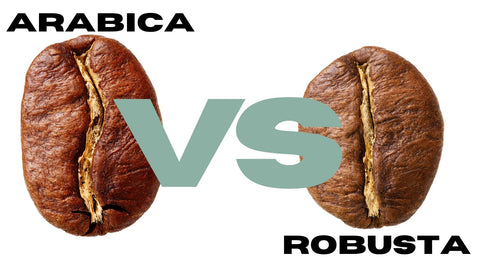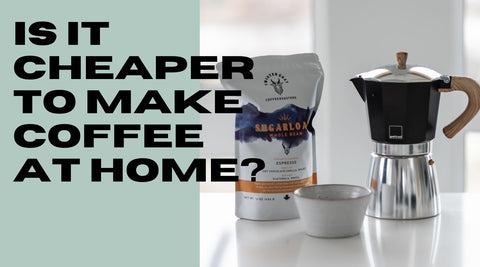If your morning cup of coffee is not tasting like you wish it would it could be that you are using a coffee bean from not your desired coffee plant!
Many people thinking drinking a fresh brew is just a morning habit, but when your taste buds experience quality coffee, you will soon change your mind.
There are two main coffee beans species which we will explore, examine their differences, and help you decide which is for you;
-
Arabica coffee beans
-
Robusta coffee beans
When considering Arabica vs Robusta you want to carefully examine the coffee bags.
You want to see not only which beans variety you are purchasing but where it comes from and the caffeine content with one blend offering more caffeine than the other.
But let's dive in and see why Arabica and Robusta coffee beans are so highly sought after.
An Overview of Beans
The main differences that impact choice is the taste of the beans and where they are grown, and something we will delve deeper into in this article.
After all, great mornings start with a quality cup of coffee, right?
What Is Arabica Coffee?
Arabica coffee, also known as Coffea arabica, is one of the most popular species of coffee beans globally, accounting for around 60-70% of the world's coffee production. It originated in the southwestern highlands of Ethiopia and is now grown around the world, particularly in Latin America, East Africa, India, and Papua New Guinea.
Arabica beans are generally known for their superior quality compared to other coffee species. The beans tend to be larger and more elongated than Robusta beans, and have a slightly curved crease on one side.
Growing Arabica coffee requires specific conditions, including higher altitudes (600-2000 meters), steady rainfall, and temperatures between 15-24°C (60-75°F). This sensitivity to its environment, combined with the fact that Arabica is more susceptible to diseases and pests, makes it more challenging and costly to grow, contributing to its higher price compared to other types of coffee like Robusta.
What Is Robusta Coffee?
Robusta coffee, scientifically known as Coffea canephora, is the second most popular species of coffee bean used in global coffee production, following Arabica. It's native to tropical regions in central and western Africa, specifically Uganda and Sudan, but is also now grown in parts of Southeast Asia, particularly Vietnam, and Brazil.
Robusta coffee is easier and less expensive to cultivate than Arabica because it can grow at lower altitudes (sea level to around 800 meters), withstand warmer temperatures (24-30°C or 75-85°F), and is more resistant to diseases. This hardiness, along with its higher yield, makes it a more economical choice for farmers. Because of these factors and its robust flavor, Robusta is often used in instant coffees and espresso blends.
Arabica vs Robusta: The Differences
We all have our preferences and favorites whether it be for foods or beverages, but when it comes to coffee knowing what you like and finding the best quality product is a must for a great start to the day.
Let's look at the main differences between the Arabica beans and Robusta beans so you can make a well-informed decision.
-
Taste
Arabica: More aromatic, milder and offer a superior taste
The flavor of Arabica coffee is often described as smooth, delicate, and nuanced, with a wide range of flavor notes that can vary based on where it's grown. These notes can include fruity, chocolatey, nutty, or floral undertones. Arabica coffee is also typically less bitter and lower in caffeine than Robusta coffee.
Robusta: Yields a stronger, bitter, and some say acquired taste
They are known to produce coffee with a strong, bold, and often bitter flavor, featuring earthy, grainy, and sometimes rubbery or woody notes.
-
Sugars
Arabica coffee, and a big reason why we tend to love it more, has double the sugar concentration and 60% more lipids compared to that of the Robusta bean.
-
Caffeine content
While Robusta beans do yield more caffeine which many think is a good thing, Robusta makes a more bitter coffee compared to Arabica, and you'll find the coffee grown specifically for use as filler.
Robusta has a 2.7% caffeine ratio where Arabica has a milder 1.5% content.
-
Price point
Deciding between Arabica coffee or Robusta coffee you will quickly see the difference in price. In the commodity market you can expect green Arabica coffee beans to come in at double the price of its green Robust coffee beans counterpart.
-
Farming
The higher caffeine content in Robusta coffee makes it the easier farming choice with the caffeine in the flowering plants a toxin to bugs, and so impacts the price Robusta sells for (Robusta is significantly cheaper than Arabica).
-
Where you will find it
Robusta coffee is not something we in the specialty coffee community would advise drinking unless you are a fan of instant coffee (is anyone?) and it is usually found as fillers for espresso blends (apparently to enhance the crema), but is certainly the main attraction in instant coffees.
Arabica coffee has always been considered the higher quality of the two coffee species, and once you taste both, you may well agree.
-
Structure
Arabica beans showcase a longer, more oval shape whereas Robusta coffee beans tend to be shorter and more circular in construct.
-
Height of the plant
The Robusta beans plant is surprisingly larger reaching anywhere from 4.6-6m in height compared to the Arabica plants 2.5-4.5m height.
-
Chlorogenic Acids (CGA)
CGA content in the Coffea Arabica plant : 5.5-8%
CGA content in the Robusta Coffee Plant: 7-10%
-
Cultivation
The Arabica bean is today mostly produced in Brazil and accounts for 75% of the world's coffee production.
Although endemic to the Ethiopian SW highlands and widely found in subtropical climates such as South America and in places with high altitudes.
The Robusta bean is produced mainly in Vietnam coming in at 25% production.
These Robusta beans hail from the coffea canephora plant species, an extension of the rubiaceae family, which is found at lower altitudes.
-
Flavor Profile
Arabica beans offers sweeter, smoother notes with hints of chocolate and sugar, where Robusta beans tend to be harsh and have a more bitter taste and grainy mouth feel.
-
Health Benefits
Arabica coffee is known to have higher levels of antioxidants which help reduce the risk of diseases in the body.
Robusta coffee, however, also has health positives, the main plus being that it assists in reducing the over production of liver enzymes.
Arabica Vs. Robusta: Which is Better?
Naturally, choices come down to personal tastes and determined by your preferred flavor profile would indicate which bean you enjoy more between Arabica and Robusta.
Arabica coffee is essentially the more popular choice as Arabica tends to be much sweeter, however, some people enjoy the stark taste of Robusta beans often found pre-ground and ready to use.
Whether you opt for the smoother Arabica or the Robusta ground coffee option always opt for the highest quality you can afford, because while Arabica is considered the premium choice, a lower quality Arabica is easily overtaken by the highest quality Robusta.
Make great java choices and cheers to a great tasting sip.



